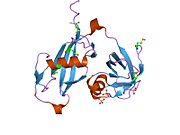N-ethylmaleimide sensitive fusion protein
Template:PBB N-ethylmaleimide-sensitive factor, also known as NSF or N-ethylmaleimide sensitive fusion proteins, is an enzyme which in humans is encoded by the NSF gene.[1][2][3]
Function
NSF is a homohexameric AAA ATPase involved in membrane fusion.[4] NSF is ubiquitously found in the cytoplasm of eukaryotic cells. It is a central component of the cellular machinery in the transfer of membrane vesicles from one membrane compartment to another. During this process, SNARE proteins on two joining membranes (usually a vesicle and a target membrane such as the plasma membrane) form a tight complex. This aids fusion of the vesicle with the target membrane. It has been proposed that the role of NSF is to undo these SNARE complexes once membrane fusion has occurred, using the hydrolysis of ATP as an energy source, allowing the dissociated SNAREs to be recycled for reuse in further rounds of membrane fusion.[5] This proposal remains controversial, however. Recent work indicates that the ATPase function of NSF does not function in recycling of vesicles but rather functions in the act of fusing vesicles with the plasma membrane.[6]
SNARE hypothesis
Because neuronal function depends on the release of neurotransmitters at a synapse — a process in which synaptic vesicles fuse with the presynaptic membrane — NSF is a key synaptic component. Thus, conditional temperature-sensitive mutations in the Drosophila melanogaster gene for NSF lead to a comatose behaviour at the restrictive temperature (and hence the gene is called comatose), presumably because neuronal functions are blocked. In Dictyostelium discoideum amoebae, similar mutations lead to a cessation of cell movement at the restrictive temperature, indicating a role for intracellular membrane transport in migration. Another neuronal role for NSF is indicated by its direct binding to the GluR2 subunit of AMPA type glutamate receptors (which detect the neurotransmitter glutamate). This gives NSF a putative role in delivery and expression of AMPA receptors at the synapse.[7]
NSF was discovered by James Rothman and colleagues in 1987 while at Stanford University; they identified NSF after observing that a cytoplasmic factor, required for membrane fusions, was inactivated by treatment with N-ethylmaleimide. This assay enabled them to purify NSF.[8]
Interactions
N-ethylmaleimide sensitive fusion protein has been shown to interact with NAPA.[9][10]
References
- ^ "Entrez Gene: NSF N-ethylmaleimide-sensitive factor".
- ^ Wilson DW, Whiteheart SW, Wiedmann M, Brunner M, Rothman JE (May 1992). "A multisubunit particle implicated in membrane fusion". J. Cell Biol. 117 (3): 531–8. doi:10.1083/jcb.117.3.531. PMC 2289450. PMID 1315316.
{{cite journal}}: CS1 maint: multiple names: authors list (link) - ^ Hoyle J, Phelan JP, Bermingham N, Fisher EM (November 1996). "Localization of human and mouse N-ethylmaleimide-sensitive factor (NSF) gene: a two-domain member of the AAA family that is involved in membrane fusion". Mamm. Genome. 7 (11): 850–2. doi:10.1007/s003359900249. PMID 8875895.
{{cite journal}}: CS1 maint: multiple names: authors list (link) - ^ Furst J, Sutton RB, Chen J, Brunger AT, Grigorieff N (September 2003). "Electron cryomicroscopy structure of N-ethyl maleimide sensitive factor at 11 A resolution". EMBO J. 22 (17): 4365–74. doi:10.1093/emboj/cdg420. PMC 202363. PMID 12941689.
{{cite journal}}: CS1 maint: multiple names: authors list (link) - ^ Alberts, Bruce (2008). Molecular biology of the cell. Garland Science. ISBN 978-0-8153-4105-5.
- ^ Kuner T, Li Y, Gee KR, Bonewald LF, Augustine GJ (January 2008). "Photolysis of a caged peptide reveals rapid action of N-ethylmaleimide sensitive factor before neurotransmitter release". PNAS. 105 (1): 347–52. doi:10.1073/pnas.0707197105. PMC 2224215. PMID 18172208.
{{cite journal}}: CS1 maint: multiple names: authors list (link) - ^ Noel J, Ralph GS, Pickard L, Williams J, Molnar E, Uney JB, Collingridge GL, Henley JM (June 1999). "Surface expression of AMPA receptors in hippocampal neurons is regulated by an NSF-dependent mechanism". Neuron. 23 (2): 365–76. doi:10.1016/S0896-6273(00)80786-2. PMID 10399941.
{{cite journal}}: CS1 maint: multiple names: authors list (link) - ^ Glick BS, Rothman JE (1987). "Possible role for fatty acyl-coenzyme A in intracellular protein transport". Nature. 326 (6110): 309–12. doi:10.1038/326309a0. PMID 3821906.
- ^ Barnard, R J (November 1997). "Stimulation of NSF ATPase activity by alpha-SNAP is required for SNARE complex disassembly and exocytosis". J. Cell Biol. 139 (4). UNITED STATES: 875–83. doi:10.1083/jcb.139.4.875. ISSN 0021-9525. PMC 2139964. PMID 9362506.
{{cite journal}}: Cite has empty unknown parameters:|laydate=,|laysummary=, and|laysource=(help); Unknown parameter|coauthors=ignored (|author=suggested) (help) - ^ Hanson, P I (July 1995). "The N-ethylmaleimide-sensitive fusion protein and alpha-SNAP induce a conformational change in syntaxin". J. Biol. Chem. 270 (28). UNITED STATES: 16955–61. doi:10.1074/jbc.270.28.16955. ISSN 0021-9258. PMID 7622514.
{{cite journal}}: Cite has empty unknown parameters:|laydate=,|laysummary=, and|laysource=(help); Unknown parameter|coauthors=ignored (|author=suggested) (help)CS1 maint: unflagged free DOI (link)
Further reading




